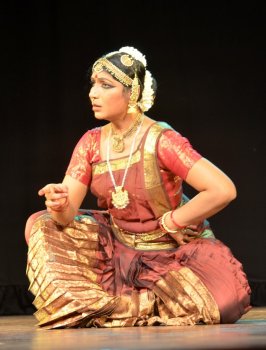
|   |

|   |
An exquisite disposition of femininity with a spiritual approach - Usha RK e-mail: simplyushark@gmail.com February 7, 2014 Was it the close to perfect execution of nritta? Or the neat and tight figure? Or the aesthetic costume and jewellery? Or the antiquated yet relevant makeup? Or the expressive face, especially the eyes? Or the time honored style of legendary Guru Kittappa Pillai? Or was it simply the spiritual elevation that evoked a spontaneous standing ovation for the performance of Narthaki Nataraj at both the programs organised by ICCR Horizon Series and Kinkini’s 30th annual dance festival. From the shloka “Manikya veena,” Narthaki exuded tremendous confidence and grace. The description of the beautiful goddess who plays the veena was depicted with utmost delicacy yet a firmness that spoke a great deal about the work that Narthaki has put into her body language. The ensuing Guru Sthuthi in Raama Manohari raga is one of the rare compositions of the Tanjore Quartet, who wanted to make a musical dedication to their guru. Keeping their guru’s ‘Guruguha’ as a seal, they composed a series of nine krithis called ‘Navaratna Krithis,’ offered it as Gurudakshana and honoured their guru. This composition “Sri Rajarajeshwari” described appropriately the seven Kanyas addressed as sapta mathas. With the trend to innovate and create more modern items, we are probably sidelining traditional and rare compositions like these. Young dancers will certainly benefit from such expositions.  Narthaki presented two varnams, the delectable “Mohamana yen meedil” in Bhairavi raga at the ICCR program and “Munnam avarodiya naamam kettal” in ragamalika composed by Thirunaavukarasar at the Kinkini Festival. This composition was a Thevaram. The nayaki, totally in love with Thiruvarur Thyagesa, waits day and night for him to pass by. The elaborate descriptions of the procession with the musicians, the dancers, the bhaktas, the decorations in flowers, etc, were etched with utmost exactitude. The nayaki hears from her friend, the supremacy of her Lord, renounces all her attachments from the worldly relationships and surrenders at his feet. Seeing the devotion, lord Thyagesa himself enlightens the devotee by explaining not to search for the divinity outside, but within the soul. Yes! Everything around and within us is God. God is one. This is what even the Azhvars and Nayanmars have written and sang all the time. This varnam depicted the story of an innocent soul in search of Shiva, she finds shivam in herself and finally the jeevathma becomes paramathma. The soul stirring interpretation of the union of the jeevatma and paramatma enraptured the audiences and had them completely engaged in the process in the last couple of minutes of the rendition. A point that Narthaki must work on is the numerous descriptions that she dishes out in a fast pace. Many a time the references of the story or situation fail to register because of the complexity of the presentation technique. Spacing the ideas in a not-so-fast pace and keeping them few in number will enhance the understandability of her exposition. In the Bharathiyar composition “Chinanchiru kiliye” too Narthaki used her mobile face and expressive eyes to delineate the heart wrenching love for the child saying that, “My heart is filled with joy with every movement of yours, everything about you only makes me rejoice but if your face shows discomfort my heart is filled with worry. When I see your forehead wrinkle, my heart flutters with fear.... and if I even see small droplet of tears in your eyes my heart bleeds... O Kannamma.” The expressions in this particular last line was so impactful that Narthaki would do better to end the item there itself, instead of going on to describe the mundane actions of putting a baby to sleep and exiting in the clichéd and oft used asking the audience to keep silent as the little one sleeps! It was a pleasure to watch Narthaki keeping strictly to the erstwhile style of her Guru Kittappa Pillai in the thillana. Beginning with the neck and eye movements, Narthaki's attamis left a smile on the faces of the dancers present in the auditorium. The beautiful choreography included simple adavus, specially the ones that use the body stretch patterns. These have actually attained an 'antique' status in recent times. The choreography of thillanas are clipped and kept short to suit the modern version though the inclusion of these languorous movements, the kudittamettu, the ta tai ta ha and mandi adavus are the mainstay of thillana patterns. Narthaki had a well-equipped music ensemble accompanying her. Randhini's vocal expertise enhanced the recital largely. Usha RK is a writer and Arts Consultant. |